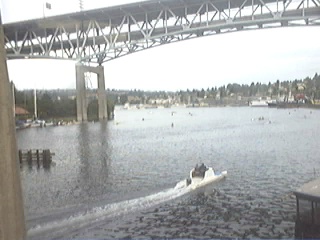
An webcam operated by the SORFED project from the UW Applied Physics Laboratory was placed underneath the University Bridge in Seattle WA and positioned such that it overlooked the portion of Portage Bay underneath I-5. A stream of jpg images produced by this camera were then tagged for the presence of boats. The purpose of this tagging was to generate outcome variables to be predicted by the images' features.
More specifically, a hypothetical grid of 14 x 20 = 280 blocks was superimposed over each image. For each image we:
Our project's collaborators intially tagged 5000 images (Set 0 below). Subsequently, undergraduate students from the University of Washington were hired to tag 40000 more images divided into 4 sets (Sets 1-4 below), which each set being scored by two different students to control for inter-operator variability.
A manual that goes into detail about the tagging and the data can be found here.
The jpg original images:
| Set0-Images.zip (149.5 MB), Set0-Images.tar.gz (147.9 MB) | Set1-Images.zip (291.4 MB), Set1-Images.tar.gz (284.6 MB) | Set2-Images.zip (294.9 MB), Set2-Images.tar.gz (288.4 MB) | Set3-Images.zip (290.5 MB), Set3-Images.tar.gz (283.5 MB) | Set4-Images.zip (294.3 MB), Set4-Images.tar.gz (287.0 MB) |
The image summary and tagging data are saved in R Statistical Computing and Graphics Software "R Saved Workspace" (.RData) format. Each SetX.RData file contains a list object.
| Set0.RData (9.7 MB) | Set1.RData (20.0 MB) | Set2.RData (19.8 MB) | Set3.RData (19.7 MB) | Set4.RData (20.8 MB) |
This project's collaborators were:
Our analysis using the above data can be found in Kim, A.Y., Marzban, C., Percival D.B. and Stuetzle, W. (2009). "Using labeled data to evaluate change detectors in a multivariate streaming environment." Signal Processing, 89, 2529-2536.
We would like to thank the personnel behind the SORFED project (Kevin Williams, Russ Light and Timothy Wen) for supporting us in the use of their data. This work was funded by the U.S. Office of Naval Research under grant number N00014-05-1-0843.
Please refer any questions to Albert Y. Kim.